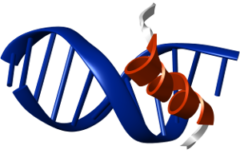8th Structural Biology Club of the Czech Society for Structural Biology
online on
27 April 2022, 1 pm
with the following scientific talks kindly delivered by our guests:
Mechanistic insights into 14‐3‐3‐mediated DAPK2 inhibition
Presented by Tomáš Obšil, Department of Physical and Macromolecular Chemistry, Faculty of Science, Charles University
Death‐associated protein kinase 2 (DAPK2) is a CaM‐regulated Ser/Thr protein kinase, involved in apoptosis, autophagy, granulocyte differentiation and motility regulation, whose activity is controlled by autoinhibition, autophosphorylation, dimerization and interaction with scaffolding proteins 14‐3‐3. However, the structural basis of 14‐3‐3‐mediated DAPK2 regulation remains unclear. We recently showed that Thr369 phosphorylation at the DAPK2 C‐terminus creates a high‐affinity canonical mode III 14‐3‐3‐binding motif, further enhanced by the diterpene glycoside Fusicoccin A. Moreover, concentration‐dependent DAPK2 dimerization is disrupted by Ca2+/CaM binding and stabilized by 14‐3‐3 binding in solution, thereby protecting the DAPK2 inhibitory autophosphorylation site Ser318 against dephosphorylation and preventing Ca2+/CaM binding.
Semaphorins and plexins – orchestrating signalling in time and space
Presented by Daniel Rozbeský, Department of Cell Biology, Faculty of Science, Charles University
Semaphorin ligands and their plexin receptors are one of the classical cell guidance factors that play essential roles in cell processes requiring discrete changes in the cytoskeleton. Beyond axon guidance, semaphorin–plexin signalling is implicated in a plethora of physiological functions, including angiogenesis, cardiovascular development, cell migration, tumour progression and immune responses.
In this talk, I will briefly review recent advances in our understanding of semaphorin‐plexin signalling. The bulk of the talk will be our studies showing the roles of heterodimerization and cis interactions in fine‐tuning of cell signalling. I will also focus on questions that are currently of high interest in my lab, in particular, how signalling molecules MICALs sculpt the actin cytoskeleton and how proteoglycans modulate semaphorin‐plexin signalling.
Moderator: Jiří Pavlíček, Institute of Biotechnology of the Czech Academy of Sciences
Please, join us on this Zoom link (join 5-10 minutes before the beginning)
https://cesnet.zoom.us/j/93482836889?pwd=OXVQVkJsS0hOZVBWbmdUR096aHh0QT09
Meeting ID: 934 8283 6889
Passcode: 983648
